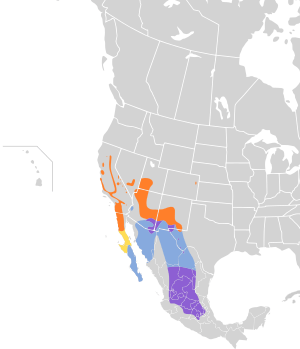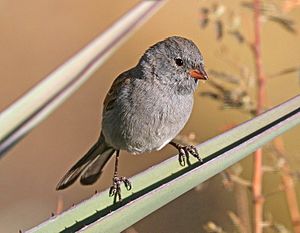Black-chinned sparrow facts for kids
Quick facts for kids Black-chinned sparrow |
|
|---|---|
 |
|
| Conservation status | |
| Scientific classification | |
| Genus: |
Spizella
|
| Species: |
atrogularis
|
 |
|
| Range of black-chinned sparrow
Breeding Non-Breeding Year-round Migration
|
|
The black-chinned sparrow (Spizella atrogularis) is a small bird found in the southwestern United States and Mexico. It belongs to the New World sparrow family. Many of these birds fly south for winter. Others in Mexico stay in the same area all year.
This sparrow is slim with a long tail. It is mostly gray with a reddish-brown back. Its wings and tail are brown. It has a pink beak and brownish legs. During breeding season, male sparrows have black on their chin and throat. Females, young birds, and non-breeding males have little or no black. This bird is quiet and often forages slowly on the ground. It eats seeds in winter and insects in summer. The female builds a cup-shaped nest and lays 2–5 pale blue eggs. Both parents help feed the young birds.
The black-chinned sparrow was first described in 1851. There are four different types, called subspecies. Most northern birds move south for winter. This bird has a large population and a wide range. Because of this, it is considered a species of least concern. However, warmer global temperatures could affect its numbers.
Contents
Understanding the Black-chinned Sparrow's Name
A German bird expert, Jean Louis Cabanis, first described this sparrow in 1851. He found a specimen near Mexico City. He first named it Spinites atrogularis. Soon after, it was moved to the group of birds called Spizella. It has stayed in this group ever since.
The Spizella group includes six small New World sparrows. The black-chinned sparrow is related to the field sparrow. Sometimes, it even mixes with the Brewer's sparrow.
There are four recognized types, or subspecies, of the black-chinned sparrow:
- S. a. evura: This type lives in the southwestern United States and northwestern Mexico. It is also known as the Arizona black-chinned sparrow.
- S. a. caurina: This type is found in west-central California. It is sometimes called the San Francisco black-chinned sparrow.
- S. a. cana: This type lives in southwestern California and northwestern Mexico. It is known as the California black-chinned sparrow.
- S. a. atrogularis: This is the original type described by Cabanis. It lives in north-central Mexico and is called the Mexican black-chinned sparrow.
The name Spizella comes from an Ancient Greek word. It means "finch," which is another type of small bird. The species name atrogularis comes from two Latin words. Ater means "black" and gularis means "throated." So, atrogularis means "black-throated." The common name "sparrow" has been used for birds since before the 12th century.
What Does a Black-chinned Sparrow Look Like?
The black-chinned sparrow is a small passerine bird. It measures about 13 to 15 centimeters (5.0 to 5.8 inches) long. Its wingspan is about 20 centimeters (7.75 inches). It weighs between 9 and 14.8 grams (0.32 to 0.52 ounces). On average, it weighs about 11.3 grams (0.40 ounces).
This bird has a slender body and a round head. It has a high crown (top of the head) and a long, notched tail. Its tail is longer than those of other Spizella sparrows. Males are slightly larger than females.
The adult bird's head and body are gray. Its back is reddish-brown with black streaks. Its belly is a dull white. The rump and uppertail coverts (feathers above the tail) are plain gray. Its wing and tail feathers are dark brown with lighter edges.
Male vs. Female Appearance
During the breeding season, male sparrows have a lot of black on their chin, throat, and face. They lose most of this black when it's not breeding season. Older males might keep some black spots. Females have little to no black on their face, chin, or throat at any time of year. This makes it hard to tell males and females apart outside of breeding season.
Young sparrows look like adults that are not breeding. They have faint streaks on their belly. They also have two light wingbars (stripes on the wings). Their head and belly have a brownish tint. Their legs and feet are dark brown. Their bill is small, strong, and pink.
What Does a Black-chinned Sparrow Sound Like?
Its call is a high, soft tsip or stip. When flying, it makes a soft ssip sound. This call is similar to the chipping sparrow's call.
The black-chinned sparrow has two types of songs. Its song is a series of clear, high-pitched whistles. These whistles speed up into a fast trill. The trill usually gets higher in pitch. Its song is like the field sparrow's song, but higher-pitched and more "mechanical."
How to Tell it Apart from Similar Birds
The black-chinned sparrow has a gray head and body. This look is unique among New World sparrows. It looks a bit like the dark-eyed junco. However, the black-chinned sparrow is slimmer. It also does not have white feathers in its tail like the junco.
Where Do Black-chinned Sparrows Live?
The black-chinned sparrow breeds in the southwestern United States. It also lives throughout much of Mexico. You can find it from northern California to western Texas. It also lives as far north as southern Nevada and Utah. Sometimes, it is seen in Oregon and Colorado.
This bird prefers dry and semi-dry areas. It lives in places with chaparral (dense shrubs), sagebrush, pine-juniper forests, and other brushy shrubland.
How Do Black-chinned Sparrows Behave?
The black-chinned sparrow seems common in its range. However, it is a quiet bird and can be hard to spot. In Mexico, you usually see them alone or in pairs. They are rarely in small groups. In the United States, they are often in small, loose groups. Sometimes, they mix with Brewer's or chipping sparrows.
They fly close to the ground with a wavy flight style. These birds often stay hidden in thick bushes. But males will sing from open, easy-to-see spots.
What Do Black-chinned Sparrows Eat?
They look for food on or near the ground. They spend a lot of time searching in the same area. We don't know everything about their diet. But they seem to eat mostly seeds in winter. In summer, they eat insects. During breeding season, they eat both plants and insects. In winter, they mainly eat seeds found on the ground.
How Do Black-chinned Sparrows Raise Their Young?
We don't know much about how black-chinned sparrows breed. They breed from late April into May. The nest is a shallow, open cup. It is made of plant materials like grasses, weed stems, and rootlets. They line the nest with fine fibers or grasses. Sometimes, they use hair or feathers. The nest is usually less than 1.2 meters (4 feet) off the ground.
The female lays 2 to 5 very pale blue eggs. These eggs are usually plain. Sometimes, they have brown spots. The female does most or all of the incubation. This takes about 13 days. Both parents bring food to the young birds after they hatch. We don't know how long it takes for the young birds to leave the nest.
Conservation and Threats to Black-chinned Sparrows
The total number of black-chinned sparrows is not known. However, their population is decreasing. The US Fish and Wildlife Service considers it a "Bird of Conservation Concern." Still, it is thought to have a large population. It also lives across a huge area. Because of this, the International Union for Conservation of Nature says it is a species of least concern.
Garter snakes are known to eat their eggs and young from the nest.
See also
 In Spanish: Gorrión barbinegro para niños
In Spanish: Gorrión barbinegro para niños




